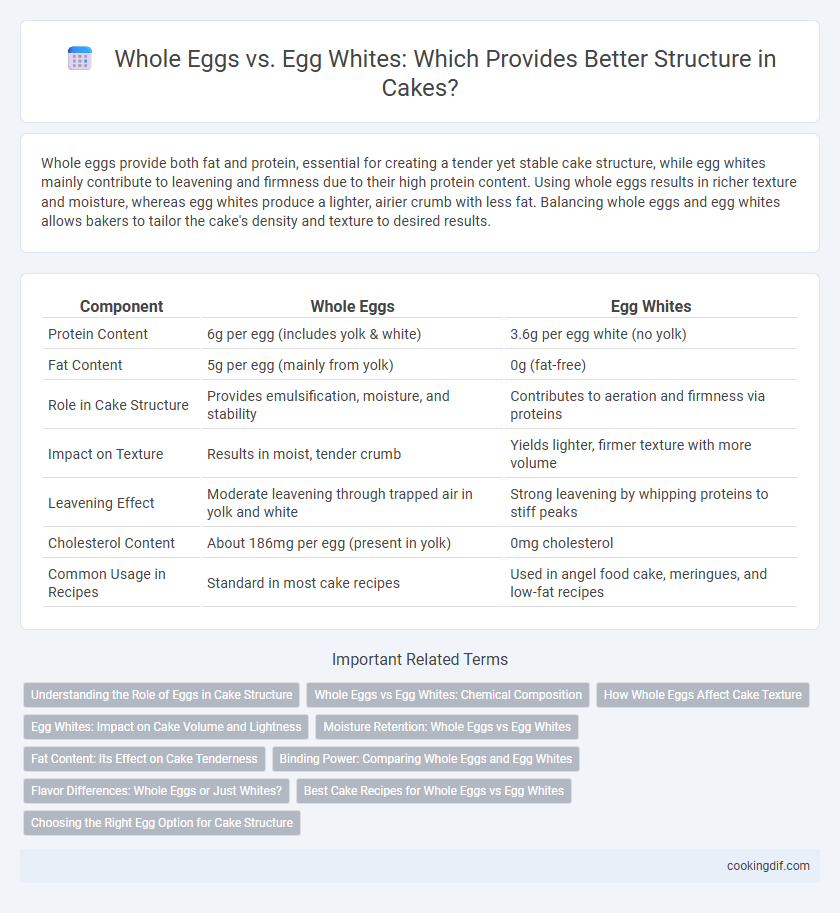Whole eggs provide both fat and protein, essential for creating a tender yet stable cake structure, while egg whites mainly contribute to leavening and firmness due to their high protein content. Using whole eggs results in richer texture and moisture, whereas egg whites produce a lighter, airier crumb with less fat. Balancing whole eggs and egg whites allows bakers to tailor the cake's density and texture to desired results.
Table of Comparison
| Component | Whole Eggs | Egg Whites |
|---|---|---|
| Protein Content | 6g per egg (includes yolk & white) | 3.6g per egg white (no yolk) |
| Fat Content | 5g per egg (mainly from yolk) | 0g (fat-free) |
| Role in Cake Structure | Provides emulsification, moisture, and stability | Contributes to aeration and firmness via proteins |
| Impact on Texture | Results in moist, tender crumb | Yields lighter, firmer texture with more volume |
| Leavening Effect | Moderate leavening through trapped air in yolk and white | Strong leavening by whipping proteins to stiff peaks |
| Cholesterol Content | About 186mg per egg (present in yolk) | 0mg cholesterol |
| Common Usage in Recipes | Standard in most cake recipes | Used in angel food cake, meringues, and low-fat recipes |
Understanding the Role of Eggs in Cake Structure
Whole eggs provide both fat and protein essential for a cake's structure, contributing to moisture, richness, and stability. Egg whites mainly consist of albumin proteins which offer strong leavening and firm structure by trapping air during whipping. Using whole eggs results in tender crumb and balanced texture, while egg whites alone yield a lighter but drier cake with less fat content.
Whole Eggs vs Egg Whites: Chemical Composition
Whole eggs contain both yolk and white, providing a balance of proteins, fats, and emulsifiers crucial for cake structure, while egg whites primarily offer albumin proteins that contribute mainly to aeration and stability. The fat in yolks enhances richness and tenderizes the crumb, whereas the proteins in whites coagulate during baking to create firmness and volume. Using whole eggs results in a moist, stable cake with balanced structure, whereas egg whites alone yield a lighter but drier texture with less emulsification.
How Whole Eggs Affect Cake Texture
Whole eggs contribute to a richer, moister cake texture by providing both fat and protein that create a tender crumb and stable structure. The yolks add emulsifiers and fats that enhance softness, while the whites supply albumin proteins that help in setting the cake's form during baking. Using whole eggs results in a balanced texture with improved volume compared to egg whites alone, which produce a lighter but drier crumb.
Egg Whites: Impact on Cake Volume and Lightness
Egg whites significantly enhance cake volume and lightness by trapping air during whipping, creating a stable foam that expands in the oven. Their high protein content coagulates upon baking, providing structure without added fat, resulting in a tender yet airy crumb. Compared to whole eggs, egg whites reduce density and contribute to a lighter texture, making them ideal for sponge cakes and angel food cakes.
Moisture Retention: Whole Eggs vs Egg Whites
Whole eggs contribute more moisture retention in cakes due to their natural fat content present in the yolks, which enhances softness and richness. Egg whites provide structure through protein coagulation but can result in drier textures when used alone because they lack fat. Balancing whole eggs and egg whites optimizes both cake texture and moisture retention for a tender crumb.
Fat Content: Its Effect on Cake Tenderness
Whole eggs contain fats in the yolk that contribute to the cake's tenderness by adding moisture and richness, improving crumb softness. Egg whites are primarily protein and lack fat, resulting in a firmer cake structure but less tenderness due to reduced fat content. Choosing whole eggs enhances fat content, which plays a critical role in achieving a tender and moist cake texture.
Binding Power: Comparing Whole Eggs and Egg Whites
Whole eggs provide superior binding power in cake structure due to the combination of proteins and fats in both the yolk and white, which creates a stable matrix that holds ingredients together. Egg whites contribute primarily to protein content and create a light texture but lack the fat that strengthens the cake's overall structure. Using whole eggs enhances moisture retention and firmness, resulting in a well-bound, stable cake crumb.
Flavor Differences: Whole Eggs or Just Whites?
Whole eggs provide a richer, more complex flavor in cakes due to the fat and lecithin in the yolks, enhancing both taste and tenderness. Egg whites contribute primarily to structure and stability, offering a lighter texture but a milder flavor profile. Bakers seeking a richer, more flavorful cake often prefer whole eggs, while those aiming for a lighter, airier texture may opt for egg whites alone.
Best Cake Recipes for Whole Eggs vs Egg Whites
Whole eggs provide optimal structure and moisture for cake recipes due to the combination of fats, proteins, and emulsifiers found in both yolk and white, resulting in richer flavor and tender crumb. Egg whites mainly contribute to leavening and lightness by incorporating air when whipped, making them ideal for angel food cakes and other airy, low-fat recipes. Best cake recipes for whole eggs include classic butter cakes and pound cakes, whereas egg-white-focused recipes excel in meringue-based treats or chiffon cakes that prioritize fluffiness and lower fat content.
Choosing the Right Egg Option for Cake Structure
Whole eggs provide both fat and protein, contributing to a richer flavor and a tender, moist cake structure. Egg whites offer high protein content without fat, resulting in a firmer, lighter texture ideal for airy cakes like angel food or sponge cakes. Selecting whole eggs or egg whites depends on the desired cake density and moisture level, with whole eggs enhancing richness and egg whites improving lift and firmness.
Whole Eggs vs Egg Whites for structure Infographic

 cookingdif.com
cookingdif.com